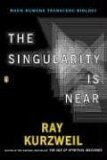Summary | Excerpt | Reviews | Beyond the Book | Readalikes | Genres & Themes | Author Bio

Critics' Opinion:
Readers' Opinion:
First Published:
Sep 2005, 672 pages
Paperback:
Sep 2006, 672 pages
Prologue
The Power of Ideas
I do not think there is any thrill that can go through the human
heart like that felt by the inventor as he sees some creation of the brain
unfolding to success.
—Nikola Tesla, 1896, inventor of alternating current.
At the age of five, I had the idea that I would become an inventor. I had the notion
that inventions could change the world. When other kids were wondering aloud
what they wanted to be, I already had the conceit that I knew what I was going
to be. The rocket ship to the moon that I was then building (almost a decade
before President Kennedy's challenge to the nation) did not work out. But at
around the time I turned eight, my inventions became a little more realistic,
such as a robotic theater with mechanical linkages that could move scenery and
characters in and out of view, and virtual baseball games.
Having fled the Holocaust, my parents, both artists, wanted a
more worldly, less provincial, religious upbringing for me. My spiritual
education, as a result, took place in a Unitarian church. We would spend six
months studying one religion—going to its services, reading its books, having
dialogues with its leaders—and then move on to the next. The theme was 'many
paths to the truth.' I noticed, of course, many parallels among the world's
religious traditions, but even the inconsistencies were illuminating. It became
clear to me that the basic truths were profound enough to transcend apparent
contradictions.
At the age of eight, I discovered the Tom Swift Jr. series of
books. The plots of all of the thirty-three books (only nine of which had been
published when
I started to read them in 1956) were always the same: Tom would get himself into
a terrible predicament, in which his fate and that of his friends, and often the
rest of the human race, hung in the balance. Tom would retreat to his basement
lab and think about how to solve the problem. This, then, was the dramatic
tension in each book in the series: what ingenious idea would Tom and his
friends come up with to save the day? The moral of these tales was simple: the
right idea had the power to overcome a seemingly overwhelming challenge.
To this day, I remain convinced of this basic philosophy: no
matter what quandaries we face—business problems, health issues, relationship
difficulties, as well as the great scientific, social, and cultural challenges
of our time—there is an idea that can enable us to prevail. Furthermore, we can
find that idea. And when we find it, we need to implement it. My life has been
shaped by this imperative. The power of an idea—this is itself an idea.
Around the same time that I was reading the Tom Swift Jr.
series, I recall my grandfather, who had also fled Europe with my mother, coming
back from his first return visit to Europe with two key memories. One was the
gracious treatment he received from the Austrians and Germans, the same people
who had forced him to flee in 1938. The other was a rare opportunity he had been
given to touch with his own hands some original manuscripts of Leonardo da
Vinci. Both recollections influenced me, but the latter is one I've returned to
many times. He described the experience with reverence, as if he had touched the
work of God himself. This, then, was the religion that I was raised with:
veneration for human creativity and the power of ideas.
In 1960, at the age of twelve, I discovered the computer and
became fascinated with its ability to model and re-create the world. I hung
around the surplus electronics stores on Canal Street in Manhattan (they're
still there!) and gathered parts to build my own computational devices. During
the 1960s, I was as absorbed in the contemporary musical, cultural, and
political movements
as my peers, but I became equally engaged in a much more obscure trend: namely,
the remarkable sequence of machines that IBM proffered during that decade, from
their big '7000' series (7070, 7074, 7090, 7094) to their small 1620,
effectively the first 'minicomputer.' The machines were introduced at yearly
intervals, and each one was less expensive and more powerful than the last, a
phenomenon familiar today. I got access to an IBM 1620 and began to write
programs for statistical analysis and subsequently for music composition.
From The Singularity is Near by Ray Kurzweil. Copyright Ray Kurzweil 2005. All rights reserved. Reproduced by permission of the publisher.





The Flower Sisters
by Michelle Collins Anderson
From the new Fannie Flagg of the Ozarks, a richly-woven story of family, forgiveness, and reinvention.

The House on Biscayne Bay
by Chanel Cleeton
As death stalks a gothic mansion in Miami, the lives of two women intertwine as the past and present collide.

The Funeral Cryer by Wenyan Lu
Debut novelist Wenyan Lu brings us this witty yet profound story about one woman's midlife reawakening in contemporary rural China.
Your guide toexceptional books
BookBrowse seeks out and recommends the best in contemporary fiction and nonfiction—books that not only engage and entertain but also deepen our understanding of ourselves and the world around us.